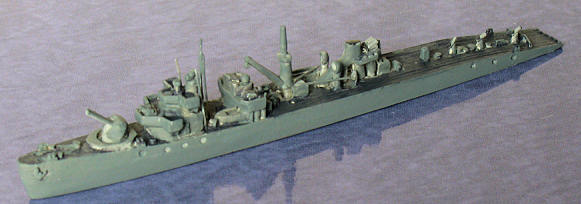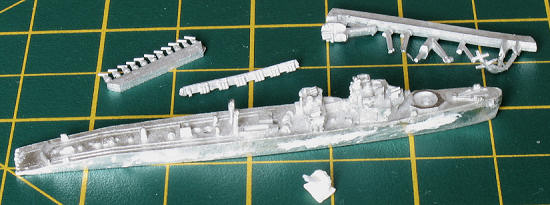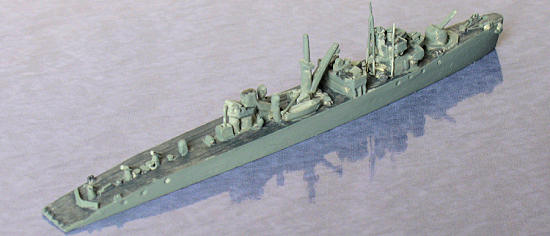
Figurehead 1/1250
T1 Type LST
| KIT #: | CJ 41 |
| PRICE: | £7.50 |
| DECALS: | none |
| REVIEWER: | Jeff Simpson |
| NOTES: | OOB build |

| HISTORY |
The ship: The T1 type LST was a
novel 1943 Japanese design of landing ship where landing craft and cargo was
launched down a sloping deck over the stern of the ship. 22 ships of this type
were launched before the end of the war, of these 1 was scrapped incomplete and
5 survived. The reference book I have does not give any details of operational
use, other than to say that they
 were often
fitted with depth charges and used as escorts (which indicates the desperate
state of affairs the Japanese military were in). Obviously with a cryptic name
like "T1" your standard search engine is going to have difficulties getting the
sort of match you want.
were often
fitted with depth charges and used as escorts (which indicates the desperate
state of affairs the Japanese military were in). Obviously with a cryptic name
like "T1" your standard search engine is going to have difficulties getting the
sort of match you want.
The manufacturer: "Figurehead" is a line of waterline miniature ship models made by a wargames manufacturer "Noble Miniatures". Unusually for metal wargames kits in this scale they come with a large number of small metal parts on sprues, most of these are overscale optional single and triple mount guns.
| THE KIT |
The metal parts come with a paper
slip inside a ziplock clear plastic bag. The paper slip has no building notes,
it gives brief historical details of the real ships. In this
case there was no twin
| CONSTRUCTION |
 You really
need a sketch profile and plan to decide where to put the parts, and if you are
going to fit any optional AA mounts. You also need to decide if you are going to
use the overscale parts provided or make up substitute masts, derricks, guns
etc.
You really
need a sketch profile and plan to decide where to put the parts, and if you are
going to fit any optional AA mounts. You also need to decide if you are going to
use the overscale parts provided or make up substitute masts, derricks, guns
etc.
I decided to fill the slight flaws
in the hull. I trimmed the moulding line around the hull sides and then applied
fine grain Milliput (white tube) filler to smooth any remaining ridge,
very small amounts of filler were also applied to the superstructure sides and
the stern.
This was lightly sanded once set.
I painted the filler with neutral grey just to check it looked ok, as a sort of
primer, with the benefit of hindsight I should have worked in primer paint
overall, the "finished" photos show the odd metallic gleam for crevices that I
did not paint.
The funnel assembly was a very
poor fit, the casting was distorted and the locating pins were too big to fit in
the holes in the deck. A considerable amount of time was spent bending the part
with pl iers
and cutting and filing away the pins, and drilling out the holes in the deck
until it fitted, when it was glued with superglue.
iers
and cutting and filing away the pins, and drilling out the holes in the deck
until it fitted, when it was glued with superglue.
I decided to substitute thin brass
wire for the tripod mast and discard the supplied bipod white metal casting, I
used the supplied large crane, but substituted nylon bristles for the king posts
and the derricks. I fitted 3 of the provided single
| COLORS & MARKINGS |
I used Testors acrylic paints
applied with a brush. I painted the decks "Panzer grey" and the sides and
superstructure "Ocean grey".
 A deck cargo
could enhance this model. Daihatsu landing craft, amphibious tanks or Kaiten
miniature submarines could be used. A German firm called Trident used to make
such accessories in 1/1250 scale and it is possible that they may still be
stocked by some internet sellers of models in this scale. Figurehead do list a
product called "Axis deck cargo" but I have no idea what that looks like, almost
certainly European theatre.
A deck cargo
could enhance this model. Daihatsu landing craft, amphibious tanks or Kaiten
miniature submarines could be used. A German firm called Trident used to make
such accessories in 1/1250 scale and it is possible that they may still be
stocked by some internet sellers of models in this scale. Figurehead do list a
product called "Axis deck cargo" but I have no idea what that looks like, almost
certainly European theatre.
I took a photo of the model with
some Trident small craft alongside, including a Japanese amphibious tank and a
Kaiten minisub, however one would need a full hull version of these craft to use
as deck cargo.
| CONCLUSIONS |
The
Figurehead kit is difficult to make and relatively expensive, on the other hand
it does allow a unique type of ship to be modelled without scratchbuilding, so
it is worth considering. As it happens I recently made a Hobbyboss plastic kit
in this scale, for much the same money, including add-on photo-etch, which
illustrates the big leap in value for money between
high volume injection moulding and low volume metal casting.
| REFERENCES |
Jentschura, Hansgeorg and Jung and
Mickel, Warships of the Imperial Japanese Navy 1869-1945, Arms and Armour, 1977,
p227
Kit provided courtesy of my
wallet, obtained from waterline-ships.co.uk
If you would like your product reviewed fairly and fairly quickly, please contact the editor or see other details in the Note to Contributors.
Back to the Review Index Page 2018